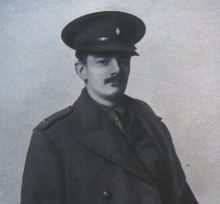George Herbert Whyte
George Herbert Whyte is best known as the co-founder, with his wife Ethel, of the International Order of the Round Table in 1908.[1]
Early life
George Herbert Whyte was born into a family of Theosophists in 1878, and joined the Society on May 25, 1894. He married his co-editor of The Lotus Journal, Ethel Mary Mallet, in 1909.[2]
Theosophical activities
Whyte met the founder of the Theosophical Society, Helena Petrovna Blavatsky during a sea voyage in 1884, becoming a personal pupil:
It was in 1884 that I first had the privilege of meeting Madame Blavatsky, and before the end of that year I was travelling from Egypt to India with her in the S.S. Navarino. The training through which she put her pupils was somewhat severe, but remarkably effective; I can testify to certain radical changes which her drastic methods produced in me in a very short space of time—also to the fact that they have been permanent!
I think I ought also to bear witness to the genuineness of those phenomena about which such a storm of controversy has raged. I had the opportunity of seeing several such happenings under circumstances which rendered any theory of fraud absolutely untenable, even at that time, when I did not in the least understand how such things could be. Now, as the result of later study, I know the methods which she must have employed, and what was then so incomprehensible perfectly simple.
If I were asked to mention Madame Blavatsky’s most prominent characteristic, I should unhesitatingly reply “Power”. Apart from the great Masters of Wisdom, I have never known any person from whom power so visibly radiated. Any man who was introduced to her at once felt himself in the presence of a tremendous force—to which he was quite unaccustomed; he realised with disconcerting vividness that those wonderful pale blue eyes saw clearly through him, and not infrequently she would soon drop some casual remark which proved to him that his apprehensions in that regard were well founded.[3]
Whyte was admitted as a member of the Theosophical Society on May 25, 1894, at the West London Lodge.[4] In 1895, he worked as secretary to Charles W. Leadbeater. For a number of years he was Assistant Manager of the Theosophical Publishing House in London.
In June, 1917, The Theosophist reported:
Cheery news comes to us from Herbert Whyte, so well known among us from his admirable work, in concert with his wife, on the Young Age, and their preceding journal for children. His work on the Round Table - the earlier one than that of the political students - has carried his name round the world to all our National Societies. He volunteered for active service early in the War, and was first in France, then in the Balkans. In the latter place he one night pitched himself down a ravine on to his shoulder, and broke his arm. He was shipped off to Malta to be mended and writes: "I have had three months' holiday here - my longest for twenty-three years - and have fully enjoyed it. My tent is on the sea-shore, and except when the winds blow it is delightful. I have written a small book, given five lectures on Theosophy and one on Buddhism, and we have formed a centre..." But the wandering Theosophist may not find our friend there, as he is well enough to return to the front.[5]
Order of the Round Table
In 1908, Mr. Whyte established the International Order of the Round Table,[6] with his wife Ethel as co-founder. He was Senior Knight from 1907 until his death in 1917, when Charles Webster Leadbeater took his place.
Military service
Mr. Whyte joined a volunteer hospital unit in France, in 1914. He became a Second Lieutenant in the London Irish Rifles (18th London Territorial Regiment) in 1916, serving in the France, Macedonia, and Egypt/Palestine fronts. While assigned to military duty in Malta, Lt. Whyte did research on the Knights of Malta of St. John. Lieutenant Whyte was awarded the Military Cross "for storming the almost impregnable fort of Jerusalem" on December 7-8, 1917. The honor was posthumous, as he was shot while defending Jerusalem on December 21st.[7]
Writing
The Union Index of Theosophical Periodicals listed 22 articles by or about George Herbert Whyte. Other writings include:
- Is Theosophy Anti-Christian? London: Theosophical Publishing Company, 1914. 49 pages. Sixth in the "Riddle of Life" series.
- The Great Teachers, (Adyar, Madras, India: Theosophical Publishing House, 1913). Number 2 in the series Lotus Leaves for the Young.
- H. B. Blavatsky: An Outline of Her Life. London: Percy Lund, Humphries & Co., 1909, and later Adyar, Madras, India: Theosophical Publishing House: 1920. Preface by C. W. Leadbeater. Originally published in serial form in the Lotus Journal.
- Glimpses of the Great War: Letters of a Subaltern from Three Fronts. London: Theosophical Publishing House, 1919. Published posthumously by his wife from letters.
- Reincarnation: a Key to the Riddle of Life. London: Watkins, 1918.
- The King's Uniform & Other Addresses: a Memorial Edition, etc. London: Pelican Press, 1918.
Notes
- ↑ Theosophical Society, Adyar, "The International Order of the Round Table," Daily News Bulletin of the 136th International Convention No. 1 (December 26, 2011): 7.
- ↑ "Notes" The Theosophic Messenger 10 no.10 (July, 1909): 473.
- ↑ Herbert Whyte, H. P. Blavatsky: An Outline of Her Life (Adyar, Madras, India: Theosophical Publishing House, 1920), xi.
- ↑ Theosophical Society General Membership Register, 1875-1942 at http://tsmembers.org/. See book 1, entry 11210 (website file: 1B/31).
- ↑ Annie Besant, "On the Watch-Tower" The Theosophist 38.9 (June, 1917), 239-240.
- ↑ Theosophical Society, Adyar, "The International Order of the Round Table," Daily News Bulletin of the 136th International Convention No. 2 (December 26, 2011): 7.
- ↑ The Theosophical Year Book, 1938, (Adyar, Madras, India: The Theosophical Publishing House, 1938): 222.
